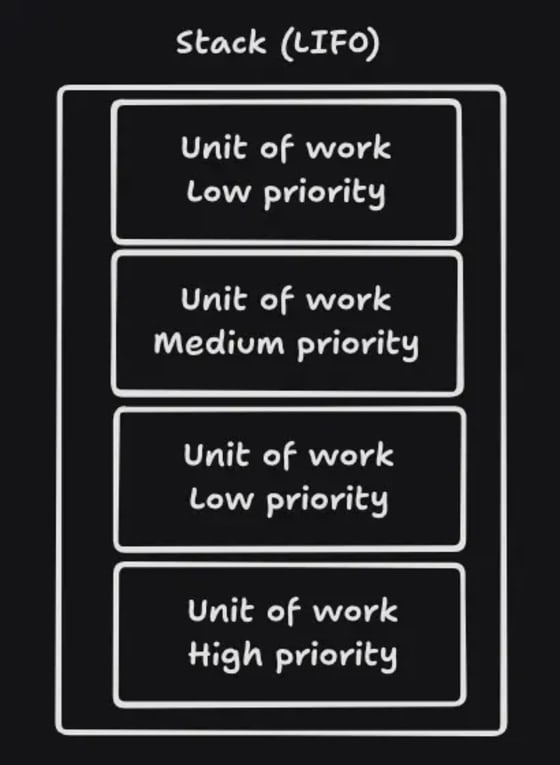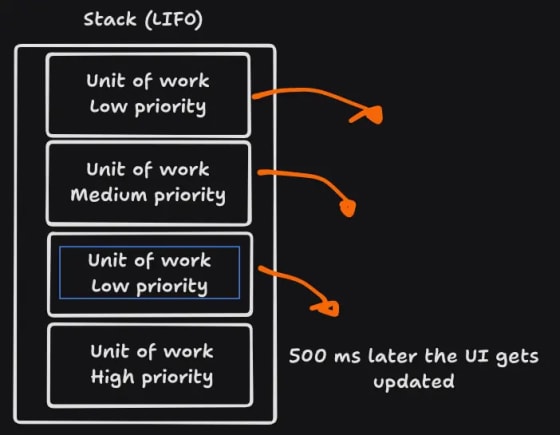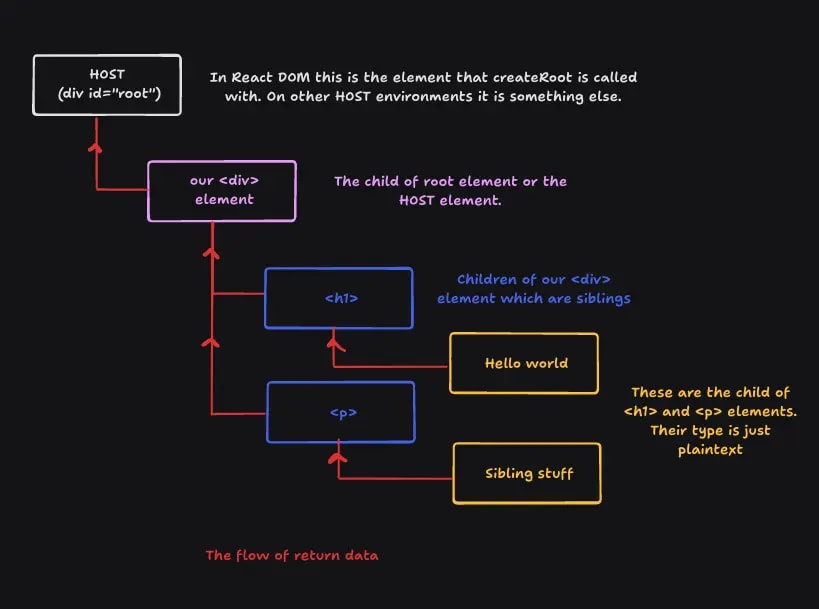
React Reconciliation and React Fiber
- react
- tutorials
It’s highly recommended to read the article and to understand that part of React and also the difference between React components and elements.
React Reconciler
React core has a package called the reconciler. Reconciler is used to build renderers for certain HOST environments. Host environments are the DOM in web development and React Native in mobile development for example.
The reconciler is in charge of determining what has changed between the previous state and the next state of the application's UI. This process is further called Reconciliation.
Reconciliation Revised
Re-creating the whole DOM tree would be slow on each state update. As a response, React has come up with its heuristic algorithm to decide whether to re-render or not. The algorithm operates in the time complexity of O(n) where n is the number of elements in the tree. As we learned from our previous post, React makes two assumptions on whether to re-render an element in the tree. As a recap, the two assumptions are:
-
Two elements of different types will produce different tree
-
Key props can be used to hint at possibly stable elements
These assumptions and their implementations are also known as the diffing algorithm which is also an important part of reconciliation. So, reconciliation is just an algorithm that React uses to determine which elements of the DOM tree need to be changed. The reconciliation algorithm forges an updated UI, which is also known as the Virtual DOM.
Virtual DOM
Virtual DOM is just a DOM tree that is kept in memory alongside the actual DOM in the browser. The virtual DOM is kept by React DOM to allow for fast manipulation of the state of the UI. These UI changes are then committed to the actual DOM tree, which will be perceived by the users.
History of the Reconciler
The current React reconciler is the React Fiber Reconciler since version 16 of React. Before the Fiber reconciler, the reconciler was a sort of stack reconciler. Since JavaScript is single threaded it can only execute a single unit of work on the main thread the old stack reconciler availed problems.
The Old Stack Reconciler
The old reconciler was pretty much just a synchronous LIFO (Last in first out) stack that handled work single unit at a time without being able to pause and return.
Suppose we have the following situation, where we are eagerly waiting for a high-priority update such as an input event to take place in our UI. There are lower-priority units of work blocking our high-priority update in the reconciler’s stack, which means we must process them before our input event gets handled. The reconciler would look like this:

Last-in-first-out stack with units of work representing the old stack reconciler.
To update the input field, the reconciler will first go through the three units of work before our update. This could mean latency for the user which will cause frustration. Imagine starting to type to an input field and it would take like 500 ms to update the UI (of course this is an exaggerated example).

Last-in-first-out stack handles the units of work solely based on the order in which the units of work has been put into the stack.
The old reconciler was missing a few key features:
-
Have a sense of priority and have a way to interrupt work.
-
UI would have been updated only once the work was ready.
The React Fiber Reconciler
These issues led to the development of a new reconciler – the Fiber reconciler. The fiber reconciler is capable of handling priority work, interrupting ongoing lower-priority work to work on a higher-priority work off-screen, and then updating the UI once finished.
This allows the Fiber reconciler to be asynchronous rather than being synchronous like the old reconciler leading to a more performant and smarter.
React Fiber Node
React Fiber is a JavaScript object that represents a unit of work to do. Like react elements – Fiber nodes are created in the process of reconciliation and they differ a bit from the react elements. Fiber nodes are mutable objects that are not re-created on every re-render as opposite of how react elements are.
React elements are converted into Fiber nodes by calling createFiberFromTypeAndProps() function. After the first initiation, the existing Fiber nodes are just updated with the necessary properties rather than re-creating it. React can relocate Fiber nodes based on the key prop and remove it completely from the tree if the corresponding React element is also removed.
React elements are the building blocks of a tree – so are Fiber nodes. Let’s demonstrate this whole thing here as it’s getting a little messy to explain in words. Suppose we have a <div> element with a <h1> and <p> elements as children.
<div>
<h1>Hello Component</h1>
<p>Sibling stuff</p>
</div>This structure can also be interpreted by the following React element object:
{
type: ”div”,
key: null,
ref: null,
props: {
children: [
{
type: "h1",
key: null,
ref: null,
props: {
children: "Hello Component"
},
},
{
type: "p",
key: null,
ref: null,
props: {
children: "Sibling stuff"
},
},
]
},
...
}Which produces the following Fiber node tree in the reconciliation process:

The React Fiber tree where each element has its children and sibling elements and also the return data flow.
Each Fiber node consists of child nodes, sibling nodes, and return nodes. In the top level is the HOST root element which may vary on the used platform. In React DOM it is the element that ReactDOM.createRoot() is called with. The root element has the rest of the application as child elements which have sibling and child elements also. This goes on until every element has a Fiber node. Each Fiber node has a return relation to its parent element.
How Reconciliation with React Fiber Works
On the first render, React will create and initialize two Fiber node trees. The current tree and workInProgress tree. The current tree is a representation of the state that was when the UI was rendered and the workInProgress tree represents the future state of the UI.
Using workInProgress tree prevents React from doing simultaneous changes to the DOM while still diffing other changes further down the tree. The rendering updates are carried out in two steps:
-
Render/Reconciliation
-
Commit
Similarly, as in the re-rendering, but here, we are not interested in the trigger step. In the render/reconciliation step, React will build the workInProgress tree and in the commit phase, it will update the DOM accordingly.
Render or Reconciliation Phase
In the render phase, React handles the new UI updates in a workLoop. If new UI updates are on the horizon the workLoop will call a function performUnitOfWork with the reference of a Fiber node from the workInProgress tree that has “work” to do. After performUnitOfWork has completed the nextUnitOfWork variable will contain a reference to the next Fiber node or null. In the case of null, React will move on to the commit phase.
The render phase logic will be something along these lines:
-
In the workLoop the performUnitOfWork will receive a Fiber node from the workInProgress tree.
-
React will start working on the Fiber node by calling beginWork function which will work on the Fiber node and return a reference to the next Fiber node or null.
-
In case of a reference to the next Fiber node, the reference will be saved into the variable nextUnitOfWork again (step 2) and in case of null (continue to step 4), React will know that it has reached the end of this branch.
-
React will start to process the sibling Fiber nodes by calling the completeUnitOfWork. After every sibling node has been gone through it will go back to the parent Fiber node.
Commit Phase
When the render/reconciliation phase is done, React has these two different Fiber node trees. The current tree and the updated workInProgress tree.
In the commit phase, React handles a lot of stuff internally like handling lifecycle methods, but in a very short and simplified version the current Fiber tree will be replaced by the workInProgress tree, and the DOM will be updated accordingly by performing DOM operations such as appends and removals.
That’s pretty much it!